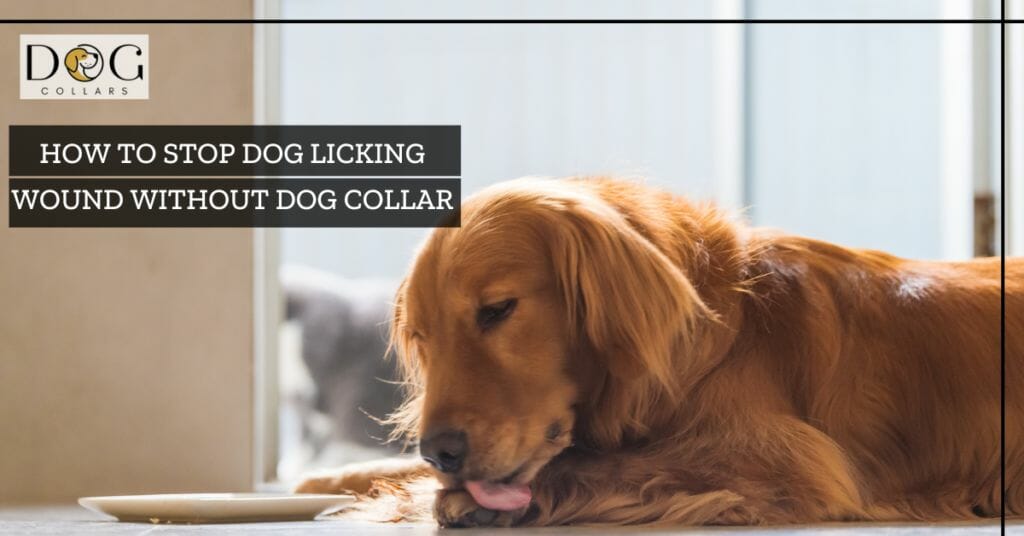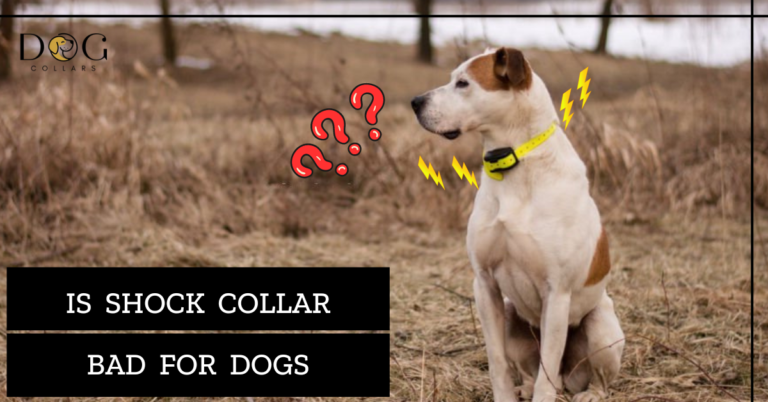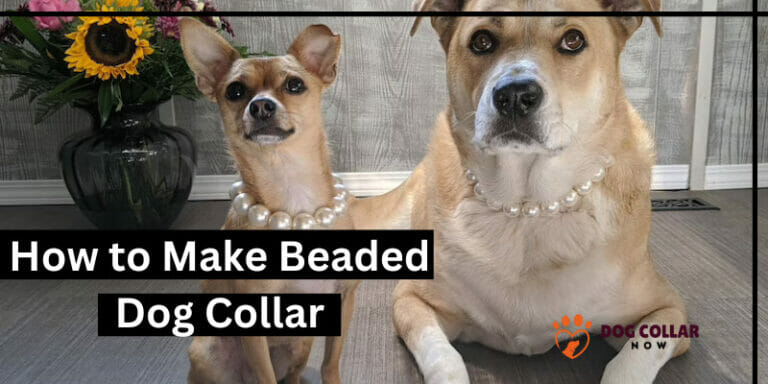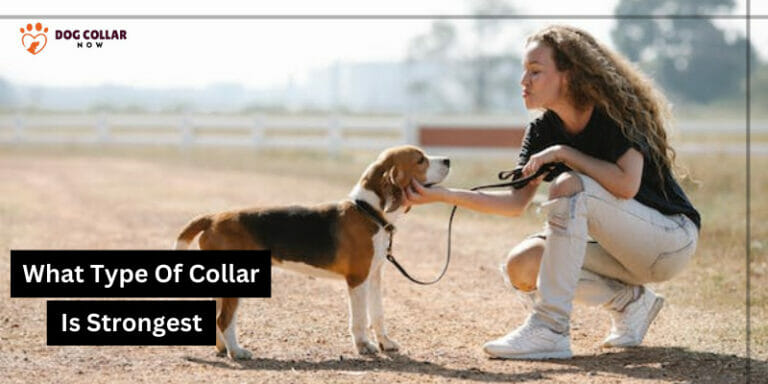How to Stop Dog Licking Wound Without Collar – 4 Methods

When my dog, got injured, I couldn’t bear to see him struggle with the “cone of shame”. Thankfully, I found these amazing alternatives to keep him from licking his wound!
It’s important to stop the licking to avoid infection and promote healing. To prevent your dog from licking its wound without a collar, try using a comfortable alternative like a soft or inflatable collar, applying a bitter-tasting deterrent, distracting your dog with toys or treats, or covering the wound with a bandage or snug shirt. Always monitor and gently discourage licking.
Traditional collars can be uncomfortable and stressful, so we’ll explore alternative methods on how to stop dog licking wound without collar.
Helpful Hint – Alternative Ways How to Stop Dog Licking Wound Without Collar
Here’s an explanation of an alternative to collars to stop your dog from licking its wound without using a collar:
1. Soft or inflatable collar:
No one likes wearing those hard plastic cones, especially our furry friends! That’s why you can opt for a more comfortable alternative like a soft or inflatable collar. These collars still do the job of preventing your dog from licking the wound, but they’re much easier on them.
Soft collars are made of soft, padded materials, while inflatable collars resemble a cushion that wraps around your dog’s neck. They both offer better mobility and can help reduce your dog’s stress during the healing process.
2. Bitter-tasting deterrents:
Hey there, if you’re looking for an alternative to a collar to prevent your dog from licking its wound. A bitter-tasting deterrent might be the answer. These deterrents come in the form of sprays, creams, or gels that have a bad taste that dogs don’t like. You just apply it to the wound area, and your dog will avoid nibbling it due to the unappealing taste.
It’s important to remember that not all products are safe for your dog, so make sure to choose one that won’t interfere with the healing process. If you’re not sure which product to use, ask your veterinarian for recommendations.
3. Distraction techniques:
Sometimes, all it takes is a little distraction to keep your dog from nuzzling wounds. Toys, puzzles, and treats are great options to keep them entertained and divert their attention from the wound. You can also engage in interactive play like fetch or tug-of-war, or provide mental stimulation through training sessions.
This will not only help distract your dog from licking but also provide a positive outlet for their energy. Just be sure to supervise them while they play to ensure they don’t accidentally aggravate the wound.
4. Protective coverings:
If you want to keep your dog from lave wounds without using a collar. You can try using a breathable bandage or a snug-fitting shirt. These coverings will help protect the wound from your dog’s tongue. Just be sure to apply the bandage correctly to avoid causing discomfort or cutting off circulation.
A snug-fitting shirt can provide an additional barrier to prevent biting, but make sure it’s not too tight and allows for proper air circulation around the wound. Remember to check the covering frequently and replace it if it gets dirty or wet to avoid infection.
Implementing these alternative methods can help your dog heal without having to use a traditional collar. This ensures their comfort and well-being during the recovery process.
Use Boots to Keep a Dog From Licking a Wound on Paws
While dog boots are primarily designed to protect a dog’s paws from rough terrain or extreme temperatures. They may not be the best solution to prevent biting wounds on paws. This may lead to reopening the wound.
Veterinarians advise that dogs can easily remove the boots. The constant removal and replacement can irritate the wound and delay the healing process. Additionally, dog boots are not designed to fit snugly around the paw, so your dog may still be able to access the wound area.
Instead, it’s better to use alternative methods like applying a bitter-tasting deterrent or a protective covering such as a breathable bandage or a snug-fitting shirt. Choosing the appropriate method depends on the location and severity of your dog’s injury. Always consult with a veterinarian for the best course of action to ensure proper and comfortable healing.
Use a Surgical Recovery Suit
A surgical recovery suit keeps your dog from licking and can be an effective alternative to a collar or bandage to prevent a dog from biting a wound. It provides full-body protection and helps keep the wound area clean. However, it may not be suitable for all dogs or injuries. It’s important to choose the right size and style for your dog. Consult with your veterinarian to determine if a surgical recovery suit is the best option for your dog’s recovery.
Understanding the Elizabethan Collar and Its Uses in Veterinary Medicine
The Elizabethan Collar, also known as the “Cone of Shame,” is a plastic cone-shaped device used in veterinary medicine to prevent pets from licking, biting, or scratching areas that need protection during recovery. The collar’s wide base sits around the pet’s neck and prevents them from accessing the affected area, and it’s secured with Velcro or snaps that allow for a proper fit. while wearing collars some pets may even refuse to eat or drink.
Here are the uses of the Elizabethan Collar:
- Used after surgeries like spaying or neutering to discourage your dog from licking or biting the incision site.
- Used in cases where pets have skin wounds or hot spots to prevent them from scratching and further irritating the affected area.
- Promotes faster healing by preventing pets from accessing the affected area.
- Reduces the risk of infection by preventing pets from licking or biting wounds.
- Some pets may find the collar uncomfortable or restrictive, but they can adjust with the help of treats, toys, and positive reinforcement.
- Owners should ensure that the collar is not too tight, as it may cause discomfort or difficulty breathing.
- The Elizabethan Collar is a temporary measure that helps pets recover fully from injuries or surgeries.
Home Remedies to Stop Dogs from Licking Their Wounds
Did you know that you can make a taste deterrent spray at home to discourage your dog from licking things they shouldn’t be, like a wound? One of the best things you can make at home is bitters. You can buy bitters at the store, but making it yourself is easy and cost-effective.
All you need is:
- Two cups of apple cider vinegar (or substitute with lemon juice)
- One cup of white vinegar
- An empty spray bottle
Procedure:
Pour the vinegar into the spray bottle and shake well to mix.
To ensure that your dog doesn’t like the taste of the mixture. Apply a small amount of the bitters onto a tissue and place it in your dog’s mouth. If they spit it out or sniff it, it means they don’t like the taste.
By connecting the bad taste with the smell, your dog will be discouraged from licking the wound when you spray it on.
However, it’s essential to consult your vet before spraying bitters on an open wound. Your dog may have an allergic reaction or another underlying infection that is causing them to lick excessively. It’s crucial to address the root cause of the licking and not just the symptoms.
In conclusion, If your dog wants to lick the wound, it’s important to prevent them from doing so to avoid further irritation or infection. Making bitters at home is easy and cost-effective, and it’s essential to consult your vet before using it on an open wound.
The Dangers of Wound Licking
Wound licking is a common behavior among animals, including dogs, cats, and even humans. While it may seem like a natural and harmless way to clean a wound, there are actually several dangers associated with this practice. Here are some points to consider:
Can introduce bacteria:
When an animal licks a wound, it can introduce bacteria from its mouth into the wound, which can cause an infection. This is especially concerning if the animal has not recently cleaned their mouth or if they have a pre-existing infection.
Can slow down healing:
Licking can actually slow down the healing process by removing the scab that forms over the wound. This can delay the growth of new tissue and prolong the recovery.
Can cause more damage:
If an animal licks a wound too vigorously, it can actually cause more damage to the surrounding tissue, which can make the wound worse.
Can be a sign of anxiety:
In some cases, wound savoring can be a sign of anxiety or stress in an animal. If you notice your pet obsessively licking a wound, it may be worth talking to your veterinarian about ways to reduce their stress levels.
Can be a habit:
In some cases, animals may develop a habit of nibbling wounds even when there is no longer any benefit to the behavior. This can be difficult to break and may require the help of a veterinarian or animal behaviorist.
In conclusion, while wound savoring may seem like harmless behavior, it can actually pose several risks to both animals and humans. If you or your pet have a wound, it’s best to avoid licking it and seek medical attention if necessary.
Conclusions:
Certainly, I can help you with that! If you want to prevent your dog from licking its wound without using a collar, there are several options to consider. Make sure to keep the wound clean and bandaged if necessary. You can also distract your dog with toys or treats to redirect their attention away from the wound.
Another option is to apply a bitter-tasting spray or ointment to the wound or by using soft e-collars that help discourage licking. If your dog is licking the wound due to anxiety or stress, talk to your vet or an animal behaviorist to address the underlying issue.
Additionally, you can consider using a specialized dog recovery suit or inflatable collar that won’t restrict your dog’s movement but will prevent them from reaching the wound. It’s important to closely monitor your dog’s wound and healing progress, and if you have any concerns, it’s best to consult with your veterinarian.
FAQs:
How can I heal my dog’s wound fast?
To heal your dog’s wound quickly, it’s important to limit excessive licking. Licking irritates the wound, preventing it from healing properly. Keep the area clean and dry, and apply topical ointments recommended by your veterinarian. Plastic cone collars or dog shirts can help prevent licking as well.
Can I put Vaseline on my dog?
It is not recommended to put Vaseline on your dog, as it can actually deter your dog from grooming themselves properly and can also clog their pores. Additionally, if ingested, Vaseline can cause gastrointestinal issues.
What taste do dogs hate to stop licking?
Dogs instinctively lick their wounds to stop this behavior. They enjoy flavors like meat, cheese, and peanut butter. Despite the fact that excessive licking can upset their stomachs and cause them to vomit, dogs will continue to lick these tasty treats if given the chance.
What is a natural remedy to stop a dog from licking?
One natural remedy to stop a dog from licking is to clean the wound with water and soap. After that apply a small amount of honey or coconut oil to the affected area. These substances are known to have antibacterial properties and can help to soothe the skin, prevent infection, and reduce itchiness.
What is a natural antiseptic for dogs?
A few natural antiseptics for dogs include honey, coconut oil, apple cider vinegar, and aloe vera. Using a natural antiseptic can help to reduce the risk of complications that could lead to infection and other health issues.
What is a neck brace collar?
A neck brace collar is a medical device that is used to immobilize and support the neck after an injury or surgery. It is made of a rigid or semi-rigid material and is designed to limit movement of the neck in order to prevent further injury or promote healing.






